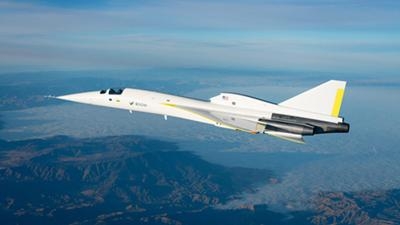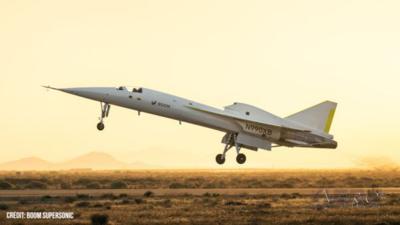Tue, Jan 14, 2025
Demonstrator Aircraft’s Next Flight Could Go Supersonic
Boom Supersonic's XB-1 took its 11th test flight on January 10, edging closer to its first supersonic flight. The aircraft reached transonic speeds of Mach 0.95, or 575 knots true airspeed, during its 44-minute flight.

The flight test was conducted at California’s Mojave Air & Space Port. Chief Test Pilot Tristan “Geppetto” Brandenburg piloted the aircraft to a maximum altitude of 29,481 feet.
The primary focus of Flight 11 was expanding dynamic pressure to 383 knots equivalent airspeed (KEAS). This is the highest dynamic pressure the aircraft will ever experience, far exceeding what is anticipated during XB-1’s first supersonic flight. The stress test is crucial for validating XB-1's structural integrity and handling characteristics under extreme aerodynamic conditions.
Dynamic pressure is a critical metric in supersonic flight testing. The XB-1 team measures the aerodynamic forces on the aircraft, then carefully expands parameters like speed and pressure incrementally to validate the aircraft’s performance and refine its flight envelope. This controlled approach minimizes risks and gathers vital data to prepare for supersonic operations.

With 11 test flights now complete, XB-1 has demonstrated consistent progress in reaching its performance goals. The aircraft previously achieved new transonic benchmarks in December 2024, with Flight 10 reaching Mach 0.95 at an altitude of 32,417 feet.
The XB-1 demonstrator, nicknamed “Baby Boom,” serves as a precursor to Boom Supersonic’s Overture, a supersonic passenger jet under development. After analyzing data from Flight 11, the team will decide if additional tests are necessary before advancing to supersonic speeds. This could mean that the aircraft will be given the green light to push past the sound barrier the next time it leaves the ground. Even if another flight is needed before this milestone, the aircraft remains on track to break the sound barrier in early 2025.
More News
“Honored to accept this mission. Time to take over space. Let’s launch.” Source: SecTrans Sean Duffy commenting after President Donald Trump appointed U.S. Secret>[...]
Permanent Echo Radar signals reflected from fixed objects on the earth's surface; e.g., buildings, towers, terrain. Permanent echoes are distinguished from “ground clutter&rd>[...]
Aero Linx: European Hang Gliding and Paragliding Union (EHPU) The general aim of the EHPU is to promote and protect hang gliding and paragliding in Europe. In order to achieve this>[...]
Glider Encountered A Loss Of Lift And There Was Not Sufficient Altitude To Reach The Airport Analysis: The flight instructor reported that while turning final, the glider encounter>[...]
Airplane Climbed To 100 Ft Above Ground Level, At Which Time The Airplane Experienced A Total Loss Of Engine Power On May 24, 2025, at 1300 eastern daylight time, an Aeronca 7AC, N>[...]
 Aero-News: Quote of the Day (07.11.25)
Aero-News: Quote of the Day (07.11.25) ANN's Daily Aero-Term (07.11.25): Permanent Echo
ANN's Daily Aero-Term (07.11.25): Permanent Echo ANN's Daily Aero-Linx (07.11.25)
ANN's Daily Aero-Linx (07.11.25) NTSB Final Report: Schweizer SGS 2-33A
NTSB Final Report: Schweizer SGS 2-33A NTSB Prelim: Aeronca 7AC
NTSB Prelim: Aeronca 7AC




